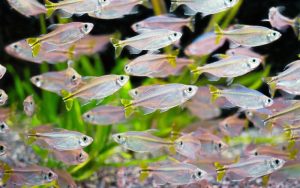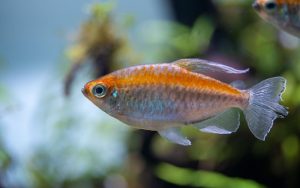Molly and platy fish are two popular species in the aquarium hobby, known for their vibrant colors and peaceful nature. While they share some similarities, such as easy care and compatibility with other fish, key differences set them apart.
Understanding these molly platy differences can help fish enthusiasts decide which species to add to their tanks. This article will explore the top vital differences and similarities between molly and platy fish. From their physical characteristics to their behavior and dietary needs, we will delve into the unique traits of each species.
Whether you are a beginner looking to start your first aquarium or an experienced hobbyist interested in expanding your collection, understanding the distinct attributes of platy and molly fish can help you create a harmonious and thriving aquatic environment.
So, let’s dive into the world of these two popular molly platy freshwater fish and discover what makes them similar and different!
Table of Contents
ToggleMolly and Platy Fish Similarities and Differences
Platies vs mollies: Both mollies and platy fish are popular freshwater aquarium fish, making them easy to compare and contrast. Here’s a breakdown of the similarities and differences between the two fish species:
Similarities:
- Livebearers: Both fish give birth to live young instead of laying eggs.
- Active Swimmers: They’re energetic and enjoy exploring their tank environment.
- Omnivorous Diet: They’ll eat various foods, including flakes, pellets, algae, and brine shrimp.
- Community Fish: Both are peaceful and do well with other peaceful fish in community tanks.
- Breeding: Relatively easy to breed in captivity, requiring minimal intervention.
- Vibrant Colors: Both come in a range of beautiful colors, though mollies tend to have brighter hues.
Differences:
- Size: Mollies are generally larger, reaching 3-4 inches, while platys are smaller, growing to 2-3 inches.
- Body Shape: Mollies have a longer, slender body, while platys have a shorter, rounder body.
- Temperament: Mollies, especially males, can be slightly more territorial, while platys are generally more docile.
- Coloration: While both have vibrant colors, mollies tend to have brighter, more metallic hues, while platys have warmer, richer colors with distinctive spots.
- Species: Mollies belong to the Poecilia family, while platys are part of the Xiphophorus family.
- Tank Requirements: Mollies require slightly larger tanks due to their size, with a minimum of 10 gallons recommended for a single molly or a pair of platies.
In summary:
- Choose mollies if: You prefer larger fish with brighter colors and don’t mind potentially dealing with slightly more territorial behavior.
- Choose platys if: You have a smaller tank, want more peaceful fish, or love fish with spots and warmer color tones.
You’re right! While both mollies and platys are omnivorous and enjoy similar diets, platies require more food throughout the day. Here’s how the hunger games break down:
- Mollies: Can thrive on two to three small daily feedings of quality flakes, pellets, and occasional treats like brine shrimp.
- Platies: With their faster metabolisms, they benefit from three or even four small feedings daily to ensure they’re getting enough energy. Remember, overfeeding is still a risk, so stick to bite-sized portions they can finish quickly.
Ultimately, choosing mollies and platys depends on your preferences and aquarium setup. Both are hardy, attractive fish that can bring life and color to your freshwater tank.
Mollies and Platies Have Different Origins
Mollies and platies are popular freshwater aquarium fish but have different origins. Mollies originate from the coastal waters of the Americas, especially Mexico, Central America, and South America.
They are adaptable to freshwater and brackish water conditions and come in various colors and patterns. Platies, on the other hand, are native to the rivers of Central America, particularly in Mexico, Guatemala, and Honduras.
They are versatile, thriving in freshwater and brackish water environments, and known for their peaceful nature and bright coloration. Both mollies and platies are livebearers, meaning they give birth to live young instead of laying eggs.
While they may share similarities in their care requirements and behavior, their different origins give them their own unique characteristics and traits. Understanding where these fish originate can help fishkeepers provide them the best care and environment in their home aquariums.
Mollies vs Platies: Which Fish is Right for Your Aquarium?
Deciding between mollies and platys comes down to personal preference and your aquarium’s capabilities. Both are vibrant, lively fish, but all these difference between molly and platy fish can impact your choice:
Size and Tank Space:
- Mollies: Grow larger, needing at least a 10-gallon tank for one or two fish. Larger groups require 20 gallons or more.
- Platys: More compact, thriving in a 10-gallon tank with a pair or group of three. Larger groups need 15-20 gallons.
Temperament and Activity:
- Mollies: Can be slightly territorial, especially males. They’re active swimmers, exploring all tank levels.
- Platys: Generally peaceful and playful, swimming throughout the tank. While less assertive than mollies, they can still display occasional fin-nipping.
Appearance and Color:
- Mollies: Boast long, slender bodies with metallic, often dazzling colors like orange, Black and white Dalmatian patterns.
- Platys: Have shorter, rounder bodies with warmer, richer tones like red, yellow orange, and blue, often featuring distinctive spots.
Breeding:
- Mollies: Prolific breeders, producing dozens of fry each month. Consider separate breeding tanks or tankmates that eat fry to manage populations.
- Platys: Also breed readily but are less prolific than mollies. Managing populations is still advisable.
Additional Considerations:
- Water Parameters: Both prefer hard water with a pH of 7.0-8.0, but mollies tolerate brackish water better.
- Diet: Both are omnivores, eating flakes, pellets, algae, and brine shrimp. Mollies may require more meaty protein.
- Compatibility: Both do well in community tanks with peaceful fish like tetras, rasboras, and corydoras.
Choosing the Right Fish:
- For larger tanks and vibrant colors, Mollies may be the ideal choice.
- For smaller tanks and peaceful communities, Platys offers a good option.
- For a less prolific breeder, Platys may be easier to manage.
- For specific color preferences, Consider the distinct color ranges of each.
Ultimately, the “right” fish depends on your priorities and tank setup. Research both species and choose the one best suits your preferences and aquarium capabilities.
Can Mollies and Platies Live Together?
Yes, Mollies and Platies can live together harmoniously in the same aquarium. Mollies (Poecilia sphenops) and Platies (Xiphophorus maculatus) are peaceful freshwater fish with similar water parameter requirements, making them compatible tank mates.
They thrive in similar water conditions, such as a temperature range of 72-82°F (22-28°C) and a pH level of 7.0-8.0. Mollies and Platies have comparable diets, consisting of high-quality flake or pellet food supplemented with occasional treats like frozen or live foods.
Providing ample space and hiding spots in the aquarium is crucial to accommodate both species. With proper care, a well-maintained tank can create an ideal environment for Mollies and Platies to coexist and thrive together, adding vibrant colors and lively activity to your aquatic display.
Can Mollies and Platies Breed? (Molly and Platy Crossbreed)
Can platy and molly breed? Yes, mollies and platies can breed! They belong to the same Poeciliidae family and share similar reproductive characteristics. This means their eggs can be fertilized by the sperm of the opposite species, resulting in hybrid offspring.
Here’s the breakdown:
- Species involved: Mollies (like sailfin mollies, black mollies, and lyretail mollies) and platies (like wagtail platies, coral red platies, and Mickey Mouse platies).
- Breeding process: Internal fertilization, with live-bearing females giving birth to fry (baby fish).
- Hybrid offspring: These fish are fertile and can produce their offspring, although subsequent generations may exhibit a broader range of traits.
Things to consider before letting your mollies and platies breed:
- Unpredictable results: Molly platy hybrid offspring may not resemble either parent species and can have varying appearances and temperaments.
- Impact on purebred lines: Interbreeding is not recommended if you’re interested in maintaining the distinct characteristics of your molly or platy strains.
- Overpopulation: Livebearers like mollies and platies are prolific breeders, so be prepared for a potential population explosion if you let them breed freely.
Overall, whether or not to allow your mollies and platies to breed is a personal decision. It can be an interesting experiment if you’re curious about the outcome and have the space to care for potential fry. Just be mindful of the potential consequences and ensure you have a plan for managing the fish population.
How to Set Up an Aquarium for Mollies and Platies?
Setting up an aquarium for mollies and platies is an exciting venture! These vibrant and active fish are relatively easy to care for, making them ideal for beginners and experienced aquarists. Here’s a step-by-step guide to get you started:
1. Choose the right tank:
- Size: Mollies and platies are moderately active fish requiring ample swimming space. For a small school (around 6 fish), a 20-gallon tank is the minimum, but a 30-gallon or larger tank is recommended for optimal comfort and water quality stability.
- Shape: Rectangular tanks offer more swimming space than curved ones, but any shape can work if it provides the necessary volume.
2. Equipment:
- Filtration: A reliable filter is crucial for maintaining good water quality. Choose a filter rated for a tank twice your size to ensure efficient waste removal. Hang-on-back filters are popular for smaller tanks, while canister filters are suitable for larger setups.
- Heater: Mollies and platies prefer warm water temperatures between 75°F and 80°F. Invest in a submersible heater with a thermostat to maintain the desired temperature range.
- Thermometer: Regularly monitor the water temperature with an aquarium thermometer.
- Lighting: While not essential for fish survival, aquarium lighting adds aesthetic appeal and helps regulate the day/night cycle, which benefits fish health. Choose LED lights for energy efficiency and adjust the lighting duration to mimic natural daylight hours (around 8-12 hours).
3. Substrate:
- Type: Opt for a fine-grained sand or gravel substrate. Mollies and platies like to sift through the substrate for food, and coarser substrates can damage their delicate barbels. Aragonite sand is an excellent choice as it helps buffer the pH and hardness of the water, which is ideal for these fish.
- Depth: A 1-2 inch substrate layer is sufficient.
4. Decorations:
- Live or artificial plants: Live plants provide hiding places, improve water quality, and add natural beauty to the tank. However, they require some maintenance. Artificial plants are easier to care for but offer fewer benefits.
- Rocks and driftwood: Rocks and driftwood can add visual interest and provide additional hiding spots for your fish. Ensure they are aquarium-safe and free of sharp edges.
5. Water conditioning:
- Tap water contains chlorine and chloramines, which are harmful to fish. Use a water conditioner to neutralize these chemicals before adding water to the tank.
- Fill the tank with dechlorinated tap water and adjust the pH to between 7.5 and 8.5, as mollies and platies prefer slightly hard and alkaline water.
6. Cycling the tank:
- Cycling the tank establishes beneficial bacteria that break down fish waste and ammonia, making the water safe for fish. This process takes about 4-6 weeks. You can use a water testing kit to monitor the ammonia, nitrite, and nitrate levels during cycling.
7. Introducing the fish:
- Once the tank is cycled and the water parameters are stable, you can introduce your mollies and platies. Start with a small group of fish and gradually add more over time.
- Acclimate the fish to the new water conditions by floating the sealed bag they came in in the tank for 15-20 minutes. Then, gradually add small amounts of tank water to the bag over 30 minutes before gently releasing the fish into the tank.
8. Maintenance:
- Perform regular water changes (10-25% of the tank water) weekly to remove waste and prevent water quality issues.
- Clean the filter and substrate as needed, following the manufacturer’s instructions.
- Test the water parameters regularly and adjust them as necessary.
- Feed your fish a high-quality diet of pellets, flakes, and frozen or live food. Avoid overfeeding, which can pollute the water.
With proper care and maintenance, your mollies or platies will thrive in their new aquarium, bringing you endless enjoyment!
How Many Platies and Mollies Can I Put in a 10-Gallon Tank?
When stocking a 10-gallon tank with platies and mollies, it’s essential to consider their adult size and behavior. Both platies and mollies are active swimmers and can grow to around 2.5 inches in length. In a 10-gallon tank, keeping a maximum of 6 platies or mollies or a mix of the two is recommended.
Overcrowding the tank can lead to stress, aggression, and poor water quality. It’s also important to consider the male to female ratio, as male platies and mollies can become aggressive towards females if outnumbered.
An excellent general rule is to have one male for every two females. It’s also important to consider the compatibility of these livebearers with other fish species, as they can be nippy towards slow-moving or long-finned fish.
When stocking a 10-gallon tank with platies and mollies, it’s essential to prioritize the health and well-being of the fish by providing adequate space and a balanced male to female ratio.
Commonly Asked Questions about the Difference Between Mollies and Platies (FAQs)
Do platys and mollies get along?
Yes! Both peaceful tropical fish, platys, and most mollies make ideal tank mates in a community setting, thriving in similar water conditions and enjoying playful interaction.
What is the difference between a Molly and a Platy?
Mollies are slightly larger and sleeker and prefer cooler colors like black and green, while platies are smaller and plump and favor warm hues like orange and red. Both peaceful tropical fish for community tanks!
How many molly fish should I have?
The ideal number depends on your molly platy fish tank size! Start with at least three mollies, aiming for 1-2 females per male for balance. Consider tank mates and breeding potential with different types of mollies. Always ensure your tank can comfortably handle their bioload. Happy fish keeping!
Can I House Mollies and Platies Together?
Platies and Mollies are peaceful, social fish from similar natural habitats in Central America. They share similar water parameters and enjoy each other’s company, making them ideal tank mates.
How Can You Tell The Difference Between Mollies And Platies?
Mollies generally have a more elongated body, while platies are shorter and rounder. Mollies are livebearers with a distinct anal fin, and compared to platies, they may need slightly different water parameters to live comfortably.
What does Molly Fish Eat?
Molly fish are omnivores, enjoying high-quality fish flakes and pellets supplemented with blanched veggies and occasionally live or frozen food like brine shrimp for a balanced diet. Aim for two to three times a day to avoid overfeeding.
What fish can live with platys?
Peaceful and friendly fish like neon tetras, Cory catfish, guppies, and dwarf Gouramis make ideal tank mates for platys. Avoid aggressive fish like barbs or larger cichlids that might bully them. Choose different species from similar water conditions and sizes for a thriving community!
Do mollies and platys need a heater?
Both species of fish, mollies or platies, require a heater. These tropical fish need consistent temperatures between 72-82°F (22-28°C) to thrive and maintain their health in an aquarium.
Can platys and tetras live together?
Platys and tetras are perfect tank mates, often living in small groups paired for their shorter and rounder bodies.
Can molly fish live in saltwater?
Mollies are brackish fish thriving in a mix of fresh and saltwater. Though they can acclimate to full saltwater tanks, gradual transitions are crucial for their long-term health. Consider brackish setups for optimal comfort!
Do mollies like aquarium salt?
Mollies tolerate but don’t necessarily require aquarium salt. While their wild ancestors inhabited brackish waters, mollies have adapted to thrive in freshwater aquariums.
What Colors do platies come in?
Platies come in a vibrant rainbow of hues! From fiery orange and sunny yellow to cool blue and even striking black and white patterns, these playful fish offer endless visual variety for your aquarium.
Conclusion
In conclusion, platy and molly fish have several differences that make them unique as aquarium fish. Molly fish are generally larger and more robust in shape compared to the sleek and slender Platy fish. Additionally, Molly fish come on a broader range of colors and patterns, making them a popular choice for aquarium enthusiasts looking to add a splash of vibrancy to their tank.
On the other hand, Platy fish are known for their peaceful and social nature, making them excellent community fish. Their smaller size and peaceful temperament make them suitable for smaller aquarium setups. While Molly and Platy fish are relatively easy to care for and are great choices for beginner fish keepers, their differences in size, appearance, and behavior offer a variety of options for fish enthusiasts to choose from when adding to their aquatic collection.
Do you have any further questions about mollies or platys? I’d be happy to provide more information!
You might also like
- Bettas and Mollies Living Together: (Tips and Pros/Cons)
- Gold Doubloon Molly Fish 101: A Comprehensive Beginner Guide
- Molly Breeder Mastery: 5 Power Tips for Explosive Growth!
- What Fish Can Live with Mollies: 7 Great Choices for Harmony
- Are Molly Schooling Fish? (9 Compatible Mollies Tank Mates)





